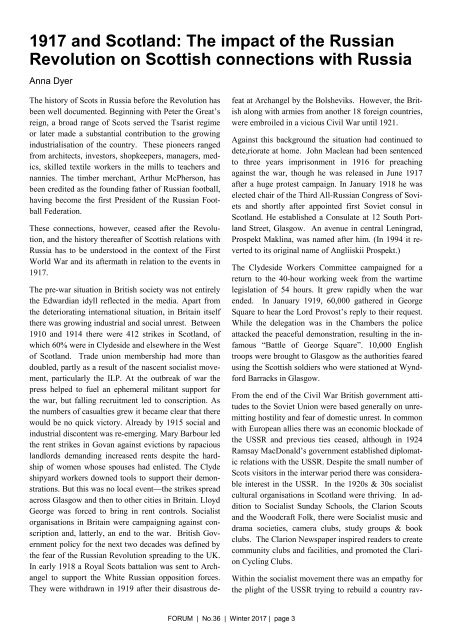You also want an ePaper? Increase the reach of your titles
YUMPU automatically turns print PDFs into web optimized ePapers that Google loves.
1917 and Scotland: <strong>The</strong> impact of the Russian<br />
Revolution on Scottish connections with Russia<br />
Anna Dyer<br />
<strong>The</strong> history of Scots in Russia before the Revolution has<br />
been well documented. Beginning with Peter the Great’s<br />
reign, a broad range of Scots served the Tsarist regime<br />
or later made a substantial contribution to the growing<br />
industrialisation of the country. <strong>The</strong>se pioneers ranged<br />
from architects, investors, shopkeepers, managers, medics,<br />
skilled textile workers in the mills to teachers and<br />
nannies. <strong>The</strong> timber merchant, Arthur McPherson, has<br />
been credited as the founding father of Russian football,<br />
having become the first President of the Russian Football<br />
Federation.<br />
<strong>The</strong>se connections, however, ceased after the Revolution,<br />
and the history thereafter of Scottish relations with<br />
Russia has to be understood in the context of the First<br />
World War and its aftermath in relation to the events in<br />
1917.<br />
<strong>The</strong> pre-war situation in British society was not entirely<br />
the Edwardian idyll reflected in the media. Apart from<br />
the deteriorating international situation, in Britain itself<br />
there was growing industrial and social unrest. Between<br />
1910 and 1914 there were 412 strikes in Scotland, of<br />
which 60% were in Clydeside and elsewhere in the West<br />
of Scotland. Trade union membership had more than<br />
doubled, partly as a result of the nascent socialist movement,<br />
particularly the ILP. At the outbreak of war the<br />
press helped to fuel an ephemeral militant support for<br />
the war, but falling recruitment led to conscription. As<br />
the numbers of casualties grew it became clear that there<br />
would be no quick victory. Already by 1915 social and<br />
industrial discontent was re-emerging. Mary Barbour led<br />
the rent strikes in Govan against evictions by rapacious<br />
landlords demanding increased rents despite the hardship<br />
of women whose spouses had enlisted. <strong>The</strong> Clyde<br />
shipyard workers downed tools to support their demonstrations.<br />
But this was no local event—the strikes spread<br />
across Glasgow and then to other cities in Britain. Lloyd<br />
George was forced to bring in rent controls. Socialist<br />
organisations in Britain were campaigning against conscription<br />
and, latterly, an end to the war. British Government<br />
policy for the next two decades was defined by<br />
the fear of the Russian Revolution spreading to the UK.<br />
In early 1918 a Royal Scots battalion was sent to Archangel<br />
to support the White Russian opposition forces.<br />
<strong>The</strong>y were withdrawn in 1919 after their disastrous defeat<br />
at Archangel by the Bolsheviks. However, the British<br />
along with armies from another 18 foreign countries,<br />
were embroiled in a vicious Civil War until 1921.<br />
Against this background the situation had continued to<br />
dete,riorate at home. John Maclean had been sentenced<br />
to three years imprisonment in 1916 for preaching<br />
against the war, though he was released in June 1917<br />
after a huge protest campaign. In January 1918 he was<br />
elected chair of the Third All-Russian Congress of Soviets<br />
and shortly after appointed first Soviet consul in<br />
Scotland. He established a Consulate at 12 South Portland<br />
Street, Glasgow. An avenue in central Leningrad,<br />
Prospekt Maklina, was named after him. (In 1994 it reverted<br />
to its original name of Angliiskii Prospekt.)<br />
<strong>The</strong> Clydeside Workers Committee campaigned for a<br />
return to the 40-hour working week from the wartime<br />
legislation of 54 hours. It grew rapidly when the war<br />
ended. In January 1919, 60,000 gathered in George<br />
Square to hear the Lord Provost’s reply to their request.<br />
While the delegation was in the Chambers the police<br />
attacked the peaceful demonstration, resulting in the infamous<br />
“Battle of George Square”. 10,000 English<br />
troops were brought to Glasgow as the authorities feared<br />
using the Scottish soldiers who were stationed at Wyndford<br />
Barracks in Glasgow.<br />
From the end of the Civil War British government attitudes<br />
to the Soviet Union were based generally on unremitting<br />
hostility and fear of domestic unrest. In common<br />
with European allies there was an economic blockade of<br />
the USSR and previous ties ceased, although in 1924<br />
Ramsay MacDonald’s government established diplomatic<br />
relations with the USSR. Despite the small number of<br />
Scots visitors in the interwar period there was considerable<br />
interest in the USSR. In the 1920s & 30s socialist<br />
cultural organisations in Scotland were thriving. In addition<br />
to Socialist Sunday Schools, the Clarion Scouts<br />
and the Woodcraft Folk, there were Socialist music and<br />
drama societies, camera clubs, study groups & book<br />
clubs. <strong>The</strong> Clarion Newspaper inspired readers to create<br />
community clubs and facilities, and promoted the Clarion<br />
Cycling Clubs.<br />
Within the socialist movement there was an empathy for<br />
the plight of the USSR trying to rebuild a country rav-<br />
<strong>FORUM</strong> | No.36 | Winter 2017 | page 3


